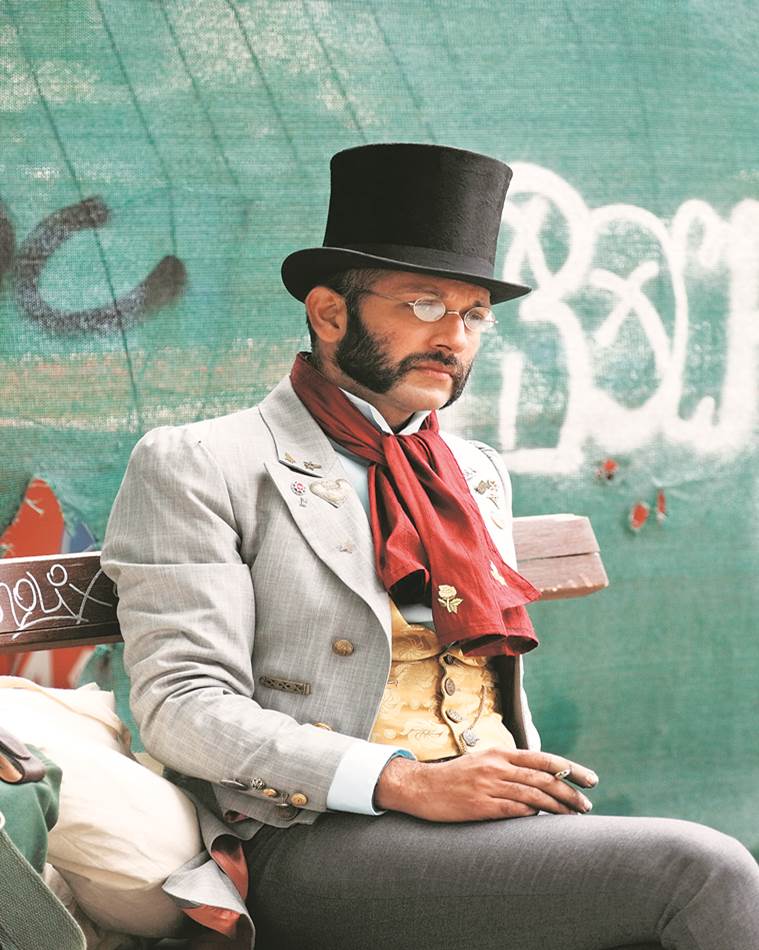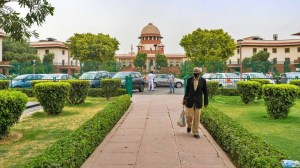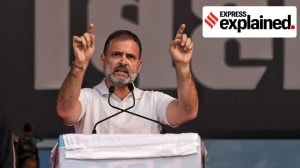- India
- International
Performance artist Nikhil Chopra on the many personas he dons and the politics of his work
‘While talking about the body, identity and history are important’
 Nikhil Chopra as the “gender-less, culture-less” nomad, during his performance at The Met in New York City. (Source: The Metropolitan Museum of Art)
Nikhil Chopra as the “gender-less, culture-less” nomad, during his performance at The Met in New York City. (Source: The Metropolitan Museum of Art)
One of India’s foremost performance artists, Goa-based Nikhil Chopra’s work brings together theatre and art, referring to the colonial past and contemporary issues. As an artist-in-residence at The Metropolitan Museum of Art (The Met) in New York last week, in the performance titled “Lands, Waters and Skies”, he assumed various roles and interacted with the museum’s objects. In an interview before the nine-day act, Chopra, 45, spoke about drawing on personal and political history in his work. Excerpts:
What is the approach you adopted for your performance at the The Met?
During the nine days at the museum (September 12-20), I paint a landscape of the sky, land and water. (As) a painter, I am interested in how a flat surface allows so much dimension, the effect it creates and our relationship with it as artists. In art school, students are trained to look at the horizon line and the vanishing point as hallmarks of representation in painting. I will bring that (critical) awareness into a Western museum of art, to examine my relationship to painting.
By calling the exhibition “Lands, Waters, and Skies”, and making them plural, I am trying to politicise these elements, by asking, whose sky, whose land and whose water?
Will you be interacting with the museum’s collection?
I will begin in the Egyptian Temple of Dendur, which was lifted from Egypt (in the 1960s) and reconstructed at the museum. It epitomises the relationship that the museum has with objects. Museums position themselves as saviours of culture but there is an audacity in how they feel they can own these objects from a different culture, dislocate them and display them like trophy heads. This is where I will make my large drawing of the sky on canvas. From here, I will head to a location before a Sol LeWitt minimalist painting, and, finally, the skylit courtyard in the Robert Lehman wing, next to which is the exhibition “In Praise of Painting: Dutch Masterpieces at The Met”.
Over the years,you have used a variety of costumes and props. How important are these for your performance?
If I were to go into the performance as Nikhil, I don’t think I will be able to take the kind of risks I do. In order to strip myself of my own identity and enter the world of performance, I wear costumes and the whole process is very transformative. You become this other person. I work very closely with the costume designer. At The Met, (Mumbai-based designer) Loise Braganza was inspired by the collection of masks, bodysuits and tribal clothing. She designed costumes that evoke a nomad, but also a kind of gender-less, culture-less creature. I end the performance in a flowing costume, with mirrors embroidered on it to imitate the night sky.

You have performed at numerous sites, from the roadside to museums. Does location matter to the performance?
The performances don’t happen in a vacuum. They are reactive and take clues from the world in which the performance takes place. It is important for me to look at the physicality of the space, its history, geopolitics and current state. In Havana (La Bienal de la Habana, 2015), for instance, I was in a plaza where I was living in a cage. It conceptually related to Cuba as a country in the middle of the ocean. There is also a cultural wall that surrounds Cuba. People in Havana related to that. For Documenta (2018), I was asked to activate both Athens and Kassel as cities. I decided to map the distance between these two cities and connect them physically by travelling from one to the other. At The Met, I am an object in the museum. Even though I am a painter, I don’t want to necessarily be a painting on the wall. I want to enter the painting and defy what art can do.
 Nikhil Chopra as Yograj Chitrakar (Source: The artist, and Chatterjee and Lal)
Nikhil Chopra as Yograj Chitrakar (Source: The artist, and Chatterjee and Lal)
You studied painting at Maharaja Sayajirao University (MSU), Baroda. Do you approach your performances from the perspective of a painter?
Painting grounds me. The slow act of making a drawing is a meditation that is part of the spectacle. People enjoy watching the act of painting. That is how I lure them into the story. I am also interested in the fact that the performances look like tableaux. For me, the painting precedes the performance. My way of rehearsing is to make drawings and paintings in my studio.
How did theatre influence your art practice in Baroda?
My father is an actor who was never really able to realise his skills as an actor on a professional stage. I grew up around his love for it. In Baroda, I joined a theatre company, The Play House, where I was able to understand the dynamics between performer and audience. While pursuing my masters in the US (Ohio State University), I took theatre classes that helped develop my skills as an actor. For me, theatre is like a colour in the palette and I am not afraid of dipping my brush in it.
Could you tell us about your first persona, Sir Raja?
I wanted to examine the idea of orientalism and exoticism. I was drawn to photographs taken at the turn of the 20th century, of the Indian maharajas, by Raja Deen Dayal and the British studios. These maharajas, swearing their allegiance to the British crown, are a metaphor for where we all stand today — somewhere between rulers and subjects of our own time. It felt distant and exotic for me to be a maharaja in my own story. During the first performance (in the US), I was seated motionless at a dining table laden with food, reminiscent of a Dutch still life painting. When I came back to India, I did a series of photographs of Kashmir with (actor) Munir Kabani and organised the piece The Death of Sir Raja III, in which the photographs and performance spoke to each other.
Then came Yog Raj Chitrakar, the persona based on your grandfather.
My grandfather was a landscape painter, who made immaculate gouache paintings of the Lidder Valley in Kashmir. I wanted to evoke that and critically examine my origins in the Valley. We were among the first families asked to leave Kashmir during the 1989 uprising. It was a way for me to create this fictional persona around my grandfather. I was able to do 10 performances with Yog Raj Chitrakar.
You have said you are as inspired by Mahatma Gandhi as by the Serbian performance artist Marina Abramovic.
I feel Mahatma Gandhi and Marina are both punks in a way. What he did with his body was deliberate. He shed the lawyer’s business suit and wore a loincloth, shaved his head and walked barefoot. He went on hunger strikes, used his body in a performative way to address his politics. Marina brings performance art into the discourse of visual art-making. She is the result of work done from the ’50s onwards, by the likes of Joseph Beuys and the Neo-Dada Organisers in Japan.
In several of your works, you turn to the colonial past.
The performances are also explorations of the past. We are talking in English and that says something about India and her educational system. It was important for our parents to teach us how to speak in English. While that has been a ticket to the world, it has also been a baggage. Punjabi is my second language and I am among the few in my generation who even learnt it. If I am talking about body, then identity and history are important.
The artist is present
Sir Raja: Sir Raja evoked an Indian Maharaja in the 19th century. Dressed in regalia, he sat before a table laden with food in Sir Raja II (2003) and in The Death of Sir Raja III (2005) posed for “the imaginary painting around his own death”.
Yograj Chitrakar: Memory drawing: A fictional character inspired by his grandfather, Yograj Chitrakar travelled from Srinagar to Chicago. In 2010, dressed as a Victorian lady, he made drawings of Mumbai’s Dr Bhau Daji Lad Museum, and at the Venice Biennale in 2009, he ate, slept and made charcoal drawings on canvas is a tower at the Arsenale for 48 hours.
Drum Solo: In this act, Chopra played a drum kit, transporting the audience to Mumbai’s ’70s rock era. In 2016, in France, he also made drawings, exploring the relationship between time and rhythm.
Blackening: In this series, if in 2012 he was in Berlin, naked and blindfolded, drawing on the walls, in 2013, he was at the KNMA in Delhi, responding to the mall the museum is located in.
La Perle Noire: This persona, at the Kochi-Muziris Biennale in 2014, referenced the region’s spice trading past. In Paris, Chopra channelled French entertainer Josephine Baker; dressed in white, he walked on pillows spread on the floor and drew on the walls.
Apr 25: Latest News
- 01
- 02
- 03
- 04
- 05







































